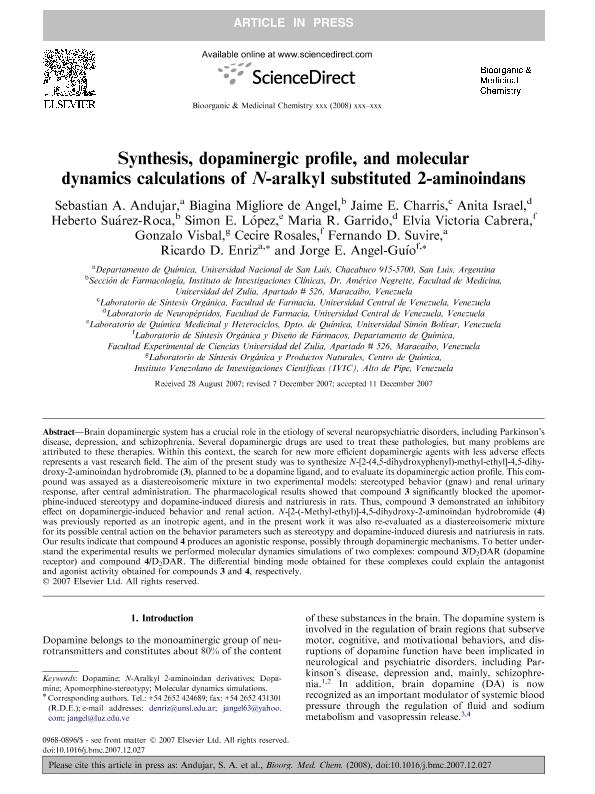Mostrar el registro sencillo del ítem
dc.contributor.author
Andujar, Sebastian Antonio

dc.contributor.author
de Angel, Biagina Migliore
dc.contributor.author
Charris, Jaime E.
dc.contributor.author
Israel, Anita
dc.contributor.author
Suárez Roca, Heberto
dc.contributor.author
López, Simon E.
dc.contributor.author
Garrido, Maria R.
dc.contributor.author
Cabrera, Elvia Victoria
dc.contributor.author
Visbal, Gonzalo
dc.contributor.author
Rosales, Cecire
dc.contributor.author
Suvire, Fernando Daniel

dc.contributor.author
Enriz, Ricardo Daniel

dc.contributor.author
Angel Guío, Jorge E.
dc.date.available
2021-04-07T15:08:14Z
dc.date.issued
2008-03
dc.identifier.citation
Andujar, Sebastian Antonio; de Angel, Biagina Migliore; Charris, Jaime E.; Israel, Anita; Suárez Roca, Heberto; et al.; Synthesis, dopaminergic profile, and molecular dynamics calculations of N-aralkyl substituted 2-aminoindans; Pergamon-Elsevier Science Ltd; Bioorganic & Medicinal Chemistry; 16; 6; 3-2008; 3233-3244
dc.identifier.issn
0968-0896
dc.identifier.uri
http://hdl.handle.net/11336/129526
dc.description.abstract
Brain dopaminergic system has a crucial role in the etiology of several neuropsychiatric disorders, including Parkinson's disease, depression, and schizophrenia. Several dopaminergic drugs are used to treat these pathologies, but many problems are attributed to these therapies. Within this context, the search for new more efficient dopaminergic agents with less adverse effects represents a vast research field. The aim of the present study was to synthesize N-[2-(4,5-dihydroxyphenyl)-methyl-ethyl]-4,5-dihydroxy-2-aminoindan hydrobromide (3), planned to be a dopamine ligand, and to evaluate its dopaminergic action profile. This compound was assayed as a diastereoisomeric mixture in two experimental models: stereotyped behavior (gnaw) and renal urinary response, after central administration. The pharmacological results showed that compound 3 significantly blocked the apomorphine-induced stereotypy and dopamine-induced diuresis and natriuresis in rats. Thus, compound 3 demonstrated an inhibitory effect on dopaminergic-induced behavior and renal action. N-[2-(-Methyl-ethyl)]-4,5-dihydroxy-2-aminoindan hydrobromide (4) was previously reported as an inotropic agent, and in the present work it was also re-evaluated as a diastereoisomeric mixture for its possible central action on the behavior parameters such as stereotypy and dopamine-induced diuresis and natriuresis in rats. Our results indicate that compound 4 produces an agonistic response, possibly through dopaminergic mechanisms. To better understand the experimental results we performed molecular dynamics simulations of two complexes: compound 3/D2DAR (dopamine receptor) and compound 4/D2DAR. The differential binding mode obtained for these complexes could explain the antagonist and agonist activity obtained for compounds 3 and 4, respectively.
dc.format
application/pdf
dc.language.iso
eng
dc.publisher
Pergamon-Elsevier Science Ltd

dc.rights
info:eu-repo/semantics/openAccess
dc.rights.uri
https://creativecommons.org/licenses/by-nc-sa/2.5/ar/
dc.subject
APOMORPHINE-STEREOTYPY
dc.subject
DOPAMINE
dc.subject
MOLECULAR DYNAMICS SIMULATIONS
dc.subject
N-ARALKYL 2-AMINOINDAN DERIVATIVES
dc.subject.classification
Físico-Química, Ciencia de los Polímeros, Electroquímica

dc.subject.classification
Ciencias Químicas

dc.subject.classification
CIENCIAS NATURALES Y EXACTAS

dc.title
Synthesis, dopaminergic profile, and molecular dynamics calculations of N-aralkyl substituted 2-aminoindans
dc.type
info:eu-repo/semantics/article
dc.type
info:ar-repo/semantics/artículo
dc.type
info:eu-repo/semantics/publishedVersion
dc.date.updated
2020-07-22T15:43:39Z
dc.journal.volume
16
dc.journal.number
6
dc.journal.pagination
3233-3244
dc.journal.pais
Estados Unidos

dc.description.fil
Fil: Andujar, Sebastian Antonio. Consejo Nacional de Investigaciones Científicas y Técnicas. Centro Científico Tecnológico Conicet - San Luis. Instituto Multidisciplinario de Investigaciones Biológicas de San Luis. Universidad Nacional de San Luis. Facultad de Ciencias Físico Matemáticas y Naturales. Instituto Multidisciplinario de Investigaciones Biológicas de San Luis; Argentina
dc.description.fil
Fil: de Angel, Biagina Migliore. Universidad del Zulia; Venezuela
dc.description.fil
Fil: Charris, Jaime E.. Universidad Central de Venezuela; Venezuela
dc.description.fil
Fil: Israel, Anita. Universidad Central de Venezuela; Venezuela
dc.description.fil
Fil: Suárez Roca, Heberto. Universidad del Zulia; Venezuela
dc.description.fil
Fil: López, Simon E.. Universidad Simon Bolivar; Venezuela
dc.description.fil
Fil: Garrido, Maria R.. Universidad Central de Venezuela; Venezuela
dc.description.fil
Fil: Cabrera, Elvia Victoria. Universidad del Zulia; Venezuela
dc.description.fil
Fil: Visbal, Gonzalo. Instituto Venezolano de Investigaciones Científicas; Venezuela
dc.description.fil
Fil: Rosales, Cecire. Universidad del Zulia; Venezuela
dc.description.fil
Fil: Suvire, Fernando Daniel. Universidad Nacional de San Luis; Argentina
dc.description.fil
Fil: Enriz, Ricardo Daniel. Consejo Nacional de Investigaciones Científicas y Técnicas. Centro Científico Tecnológico Conicet - San Luis. Instituto Multidisciplinario de Investigaciones Biológicas de San Luis. Universidad Nacional de San Luis. Facultad de Ciencias Físico Matemáticas y Naturales. Instituto Multidisciplinario de Investigaciones Biológicas de San Luis; Argentina
dc.description.fil
Fil: Angel Guío, Jorge E.. Universidad del Zulia; Venezuela
dc.journal.title
Bioorganic & Medicinal Chemistry

dc.relation.alternativeid
info:eu-repo/semantics/altIdentifier/url/https://www.sciencedirect.com/science/article/abs/pii/S096808960701067X?via%3Dihub
dc.relation.alternativeid
info:eu-repo/semantics/altIdentifier/doi/http://dx.doi.org/10.1016/j.bmc.2007.12.027
Archivos asociados
